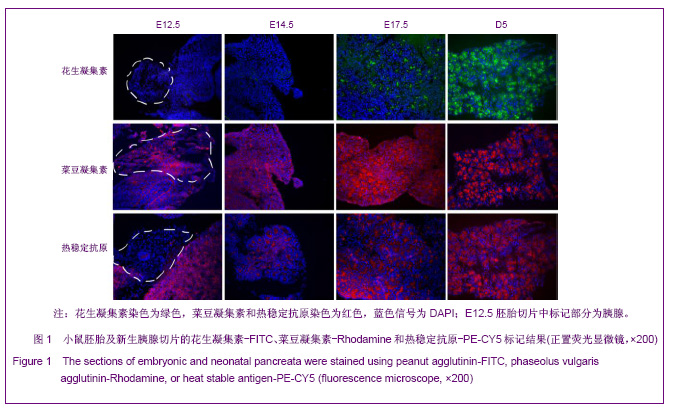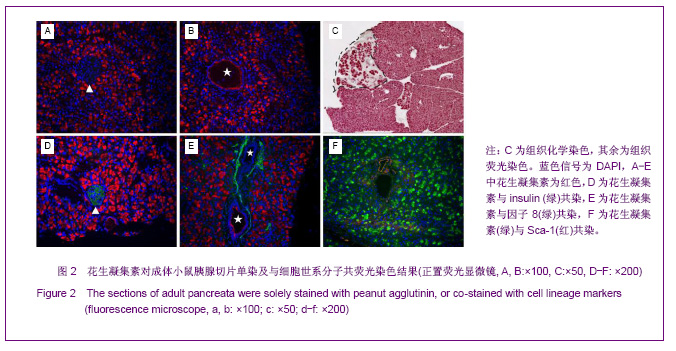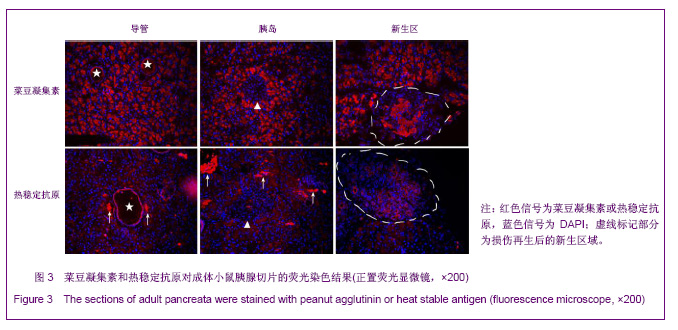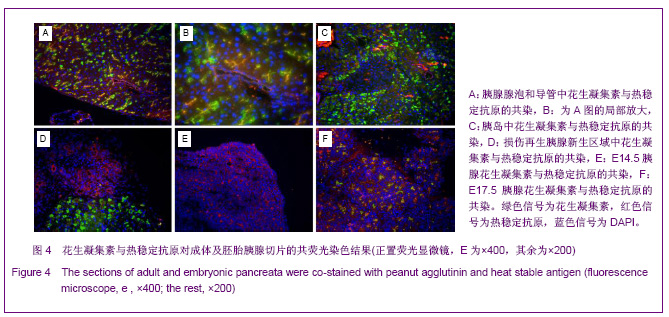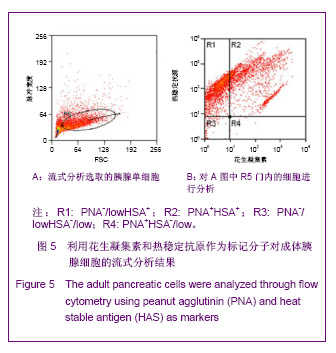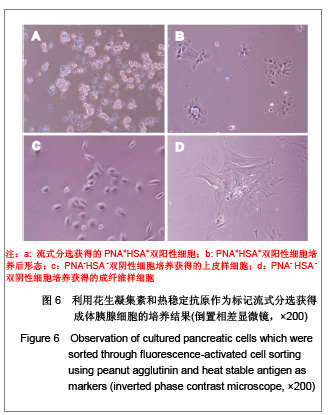| [1] Jiang FX, Morahan G. Pancreatic Stem Cells: From Possible to Probable. Stem Cell Rev. 2012;8(3):647-657. [2] Wagner RT, Lewis J, Cooney A, et al. Stem cell approaches for the treatment of type 1 diabetes mellitus. Transl Res. 2010; 156(3):169-179. [3] Stanekzai J, Isenovic ER, Mousa SA. Treatment options for diabetes: Potential role of stem cells. Diabetes Res Clin Pract. 2012. pii: S0168-8227(12)00314-2.[4] Sims E, Evans-Molina C. Stem cells as a tool to improve outcomes of islet transplantation. J Transplant. 2012; 2012: 736491.[5] Godfrey KJ, Mathew B, Bulman JC, et al. Stem cell-based treatments for Type 1 diabetes mellitus: bone marrow, embryonic, hepatic, pancreatic and induced pluripotent stem cells. Diabet Med. 2012; 29(1):14-23.[6] Zhang LX, Teng CB, An TZ. Shengwu Gongcheng Xuebao. 2008;24(2): 177-182. 张丽新,滕春波,安铁洙.利用成体干细胞治疗糖尿病[J].生物工程学报,2008,24(2):177-182.[7] Ramiya VK, Maraist M, Arfors KE, et al. Reversal of insulin-dependent diabetes using islets generated in vitro from pancreatic stem cells. Nat Med. 2000; 6:278-282.[8] Hao E, Tyrberg B, Itkin-Ansari P, et al. Beta-cell differentiation from nonendocrine epithelial cells of the adult human pancreas. Nat Med. 2006; 12:310-316.[9] Noguchi H, Oishi K, Ueda M, et al. Establishment of mouse pancreatic stem cell line. Cell Transplant. 2009; 18:563-571.[10] Smukler SR, Arntfield ME, Razavi R, et al. The adult mouse and human pancreas contain rare multipotent stem cells that express insulin. Cell Stem Cell. 2011; 8:281-93.[11] Ioannou M, Serafimidis I, Arnes L, et al. ALDH1B1 is a potential stem/progenitor marker for multiple pancreas progenitor pools. Dev Biol.2012. pii: S0012-1606(12)00601-X.[12] Wang H, Wang S, Hu J, et al. Oct4 is expressed in Nestin-positive cells as a marker for pancreatic endocrine progenitor. Histochem Cell Biol. 2009;131(5):553-563. [13] Inada A, Nienaber C, Katsuta H, et al. Carbonic anhydrase II-positive pancreatic cells are progenitors for both endocrine and exocrine pancreas after birth. Proc Natl Acad Sci U S A. 2008;105(50):19915-19919.[14] Zulewski H, Abraham EJ, Gerlach MJ, et al. Multipotential nestin-positive stem cells isolated from adult pancreatic islets differentiate ex vivo into pancreatic endocrine, exocrine, and hepatic phenotypes. Diabetes. 2001; 50:521-533.[15] Suzuki A, Nakauchi H, Taniguchi H. Prospective isolation of multipotent pancreatic progenitors using flow-cytometric cell sorting. Diabetes. 2004; 53: 2143-2152.[16] Oshima Y, Suzuki A, Kawashimo K, et al. Isolation of mouse pancreatic ductal progenitor cells expressing CD133 and c-Met by flow cytometric cell sorting. Gastroenterology. 2007; 132(2):720-732.[17] Rovira M, Scott SG, Liss AS, et al. Isolation and characterization of centroacinar/terminal ductal progenitor cells in adult mouse pancreas. Proc Natl Acad Sci USA. 2010; 107: 75-80.[18] Zhou Q, Law AC, Rajagopal J, et al. A Multipotent Progenitor Domain Guides Pancreatic Organogenesis. Dev Cell. 2007; 13(1):103-114.[19] Wagers AJ, Allsopp RC, Weissman IL. Changes in integrin expression are associated with altered homing properties of Lin(-/lo)Thy1.1(lo)Sca-1(+)c-kit(+) hematopoietic stem cells following mobilization by cyclophosphamide/granulocyte colony-stimulating factor. Exp Hematol. 2002; 30:176-185.[20] Toyoda M, Yamazaki-Inoue M, Itakura Y, et al. Lectin microarray analysis of pluripotent and multipotent stem cells. Genes Cells. 2011; 16(1): 1-11.[21] Kitada M, Kuroda Y, Dezawa M. Lectins as a tool for detecting neural stem/progenitor cells in the adult mouse brain. Anat Rec (Hoboken). 2011; 294(2): 305-321.[22] Rietze RL, Valcanis H, Brooker GF, et al. Purification of a pluripotent neural stem cell from the adult mouse brain. Nature. 2001; 412(6848): 736-739.[23] Zhang LX, Ju XF, Wang F, et al. Shengwu Gongcheng Xuebao. 2008; 24(4) :604-609. 张丽新,鞠晓芳,王法,等.利用假型反转录病毒对大部分胰腺切除后再生细胞的世系追踪[J].生物工程学报,2008,24(4):604-609.[24] Slack JM. Developmental Biology of the Pancreas. Development.1995;121(6):1569-1580.[25] Jensen J. Gene regulatory factors in pancreatic development. Dev Dyn. 2004; 229:176-200.[26] Bonner-weir S, Baxter LA, Schuppin GT, et al. A second pathway for regegneration of adult exocrine and endocrine pancreas: A possible recapitulation of embryonic development. Diabetes. 1993; 42: 1715-1720.[27] Kaligin MS, Gumerova AA, Titova MA, et al. C-kit is a marker of human pancreatic endocrinocyte stem cells. Morfologiia. 2011; 140(4):32-37. [28] Lin HT, Chiou SH, Kao CL, et al. Characterization of pancreatic stem cells derived from adult human pancreas ducts by fluorescence activated cell sorting. World J Gastroenterol. 2006; 12(28):4529-4535.[29] Newman RA, Klein PJ, Rudland PS. Binding of peanut lectin to breast epithelium, human carcinomas, and a cultured rat mammary stem cell: use of the lectin as a marker of mammary differentiation. J Natl Cancer Inst. 1979; 63: 1339-1346.[30] Schulte BA, Spicer SS. Histochemical methods for characterizing secretory and cell surface sialoglycoconjugates. J Histochem Cytochem. 1985;33:427-438.[31] Barresi G, Vitarelli E, Grosso M, et al. Peanut lectin binding sites in human foetal and neonatal pancreas. Eur J Histochem. 1993; 37(4):329-334.[32] Venable A, Mitalipova M, Lyons I, et al. Lectin binding profiles of SSEA-4 enriched, pluripotent human embryonic stem cell surfaces. BMC Dev Biol. 2005; 5:15.[33] Allen LW, Svenson RH, Yachnin S. Purification of mitogenic proteins derived from Phaseolus vulgaris: isolation of potent and weak phytohemagglutinins possessing mitogenic activity. Proc Natl Acad Sci U S A. 1969; 63(2):334-341.[34] Wang X, Hu J, Zhao D, et al. Nestinneg CD24low/- population from fetal Nestin-EGFP transgenic mice enriches the pancreatic endocrine progenitor cells. Pancreas. 2005; 31(4): 385-391.[35] Li D, Feng RC, Zhang LX, et al. Xiandai Yixue Jinzhan. 2011; 11(12):2242-2246. 李丹,冯锐成,张丽新,等.通过G418处理离体纯化小鼠胰腺上皮细胞[J]. 现代医学进展, 2011; 11(12):2242-2246.[36] Miyazaki S, Yamato E, Miyazaki J. Regulated expression of pdx-1 promotes in vitro differentiation of insulin-producing cells from embryonic stem cells. Diabetes. 2004; 53(4): 1030-1037.[37] Zhou L, Pelengaris S, Abouna S, et al. Re-expression of IGF-II is important for beta cell regeneration in adult mice. PLoS One. 2012; 7(9):e43623. [38] Domínguez-Bendala J, Lanzoni G, Inverardi L, et al. Concise review: mesenchymal stem cells for diabetes. Stem Cells Transl Med.2012; 1:59-63. [39] Kadam S, Muthyala S, Nair P, et al. Human placenta-derived mesenchymal stem cells and islet-like cell clusters generated from these cells as a novel source for stem cell therapy in diabetes. Rev Diabet Stud. 2010;7(2):168-182.[40] Xu X, D'Hoker J, Stangé G, et al. Beta cells can be generated from endogenous progenitors in injured adult mouse pancreas. Cell. 2008; 132(2):197-207. |
